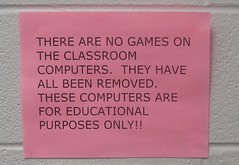3 Barriers to adoption of Serious Games/Immersive Learning Simulations

Here is my answer to the second of a series of questions from a graduate student about serious games/immersive learning environments.
The question is What have been the barriers to widespread adoption of Serious Games/Immersive Learning Simulations?
The barriers to widespread adoption:
Perception of games as only entertainment: People have grown up with the understanding that games and interactive experiences are the realm of fun, play time or vacation and education is the realm of receiving information in a serious, no-nonsense, static, non-interactive fashion with little feedback or immediate consequences for incorrect assumptions or answers other than a red mark on a paper. People tend to accept and hold in high esteem past experiences with which they are familiar. Most people making decisions about how to craft instruction in a corporate or academic environment have never learned formally via a game or simulation. They have no familiarity with the process, the techniques or the nuances necessary to learn via an interactive game or simulation and so they dismiss it as an invalid method of instruction. They then hold “classroom instruction” up as the single best model for instruction because they learned that way and because it is so common. This is the idea that “game” is a four letter word. Lack of experience learning via games/simulations combined with playing “games” only for fun leads to a perception that games/simulations aren’t a serious way to learn.
Unfamiliarity with development process: Creating linear content for a deck of slides is familiar and common for most organizations. They understand you create objectives, teach to each objective by providing the content and then test to the objective in a very linear style. This is not how a game/simulation works, instead there are variations, tangential content and non-linear interactions. Instructional design teams are not familiar with this process and many entertainment game designers don’t want to dabble in corporate or academic game design (not enough mass market) so the unfamiliarity with the development process causes hesitation and, almost more importantly, causes high costs. The design team consisting of Subject Matter Experts doesn’t understand how to create a game/simulation or the nature of non-linear content and thus causes delays, false starts and cost overrun. This is due in a large part to the first point which is they don’t have experience learning from games/simulations and their educational models are lecture-focused and centered on linear delivery of content.
Not understanding of the mechanisms in games/simulations that make them educational. First, it is important to understand that a game/simulation is not educational just because it is a game/simulation. Instead, a game/simulation is an effective educational tool primarily because of the high level of interactivity and instant feedback. Well designed games/simulations engage the learner in a constant decision making process. The learner is forced to interact and think through the content and then witnesses immediate or near immediate feedback based on his or her actions. So the most critical aspect is not the technology (which is the focus of many when thinking about games/simulations) rather the most critical aspect is the design. The design must be interactive and provide realistic or corrective feedback as the learner progresses and the game/simulation must maintain a balance between anxiety and boredom which is known as the elusive “flow state.”
Posted in: Content Guide
Leave a Comment (2) ↓